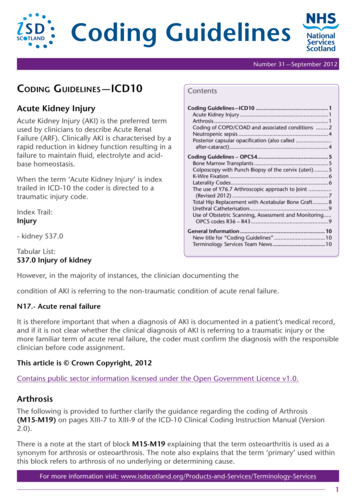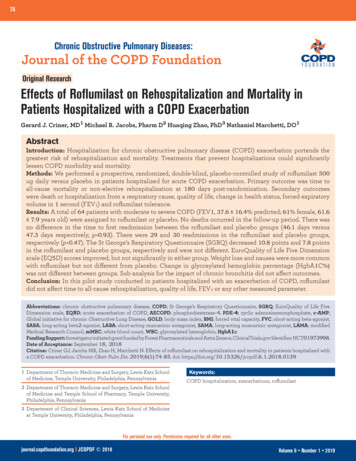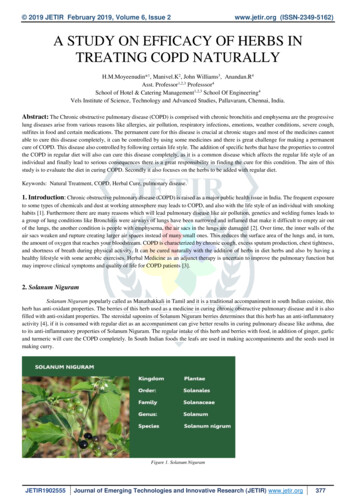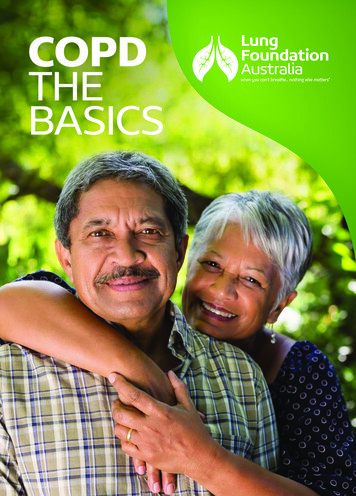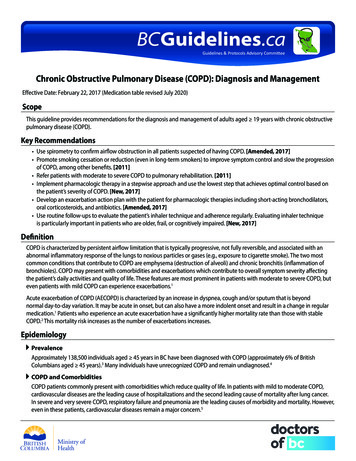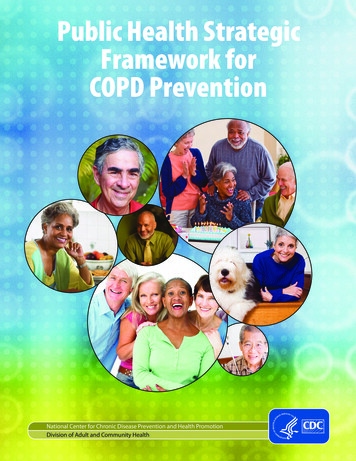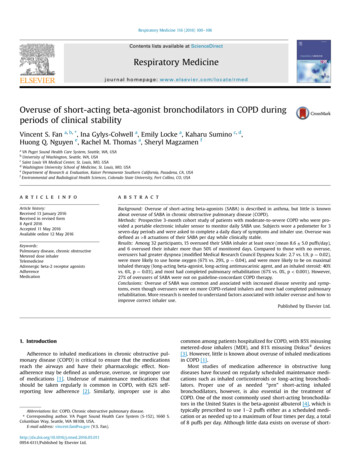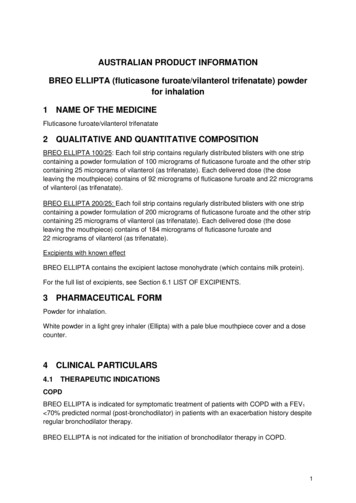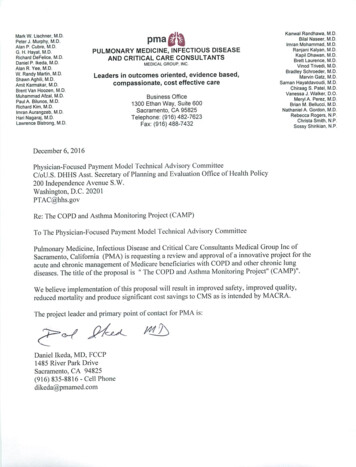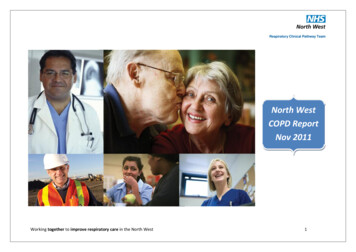
Transcription
Respiratory Clinical Pathway TeamNorth WestCOPD ReportNov 2011Working together to improve respiratory care in the North West1
Respiratory Clinical Pathway TeamContentsIntroduction – foreword by NW Respiratory Leads . 34 reasons why COPD is important in the North West. 4Facts on COPD in the North West . 51.Deaths due to COPD. 52.Life expectancy for people with COPD in the North West. 53.The ‘Missing Millions’. 84.Is there equal access to all treatment modalities within the North West? . 115.Admissions and readmissions . 126.COPD and Smoking . 157.What do North West Respiratory Patients want to tell the Respiratory Community . 168.What Steps can be taken to reduce variation in care . 179.What works in COPD . 1810. What is North West Respiratory Clinical Pathway Team doing to reduce variation? . 19Working together to improve respiratory care in the North West2
Respiratory Clinical Pathway TeamIntroduction – foreword by NW Respiratory LeadsSince our appointment in April 2010 we have worked in partnership with many organisations across North West to deliver on our aims of: Uniform High Level Standards of Care Positive Patient Experience Confident Commissioning of Effective ServicesWe have been working with respiratory teams to reduce variation in care as well as identifyingundiagnosed COPD patients.3 million people in England have COPD of which only 890,000 are registered COPD patients withtheir GP. North West has an estimated COPD population of 252,000 yet only 157,000 have beenregistered1. Certain services felt essential to the management of COPD are not universallyavailable to patients in the North West.This short report is for clinicians, allied health professionals and commissioners alike. Byworking together as integrated teams we hope to improve the care on the management of theCOPD patient.From L to R – John Williams, June Roberts, Stephen GaduzoNHS North West Respiratory Clinical Pathway Leads1Information Centre Quality and Outcomes Framework 2010/11and Eastern Region PHO COPD prevalence estimatesWorking together to improve respiratory care in the North West3
Respiratory Clinical Pathway Team4 reasons why COPD is important in the North West1.2.3.Almost 3000 people die from COPD in the North West every year2.Life expectancy for people with COPD in the North West is reduced by 15 years3One quarter of people with COPD are prevented from working due to the disease and theannual cost of COPD-related productivity to employers and the economy has been put at 3.8billion4When I come back from thedoctors, I don’t understand whatthey have said. They use bigwords – COPD Patient4.A Survey by BLF found that 90% of COPD patients were unable to participate in socially important activities such as gardening, two-thirdwere unable to take a holiday because of their disease and one thirds had disabling breathlessness5 (BLF 2007)2ONS3The Information Centre for health and social care. Crown Copyright. (NCHOD Workbench - April 2011)- data for 2007-20094Britton, M. (2003). The Burden of COPD in the UK: results from the Confronting COPD Survey. Respiratory Medicine, 97, S71-S79.5British Lung Foundation (2007). Invisible Lives - COPD - Finding the Missing Millions. British Lung Foundation.Working together to improve respiratory care in the North West4
Respiratory Clinical Pathway TeamFacts on COPD in the North West1. Deaths due to COPDRespiratory diseases are the third highest cause of mortality in England behind circulatorydiseases and Cancers6If 100 people die of COPD in England, 124 people die of COPD in North West7. There is significantvariation in death rates within the North West’s Primary Care Trust (PCT) network.Tackling health inequalities and promotingequality is central if the NHS is to deliverhealth outcomes that are among the best inthe world. – NHS Outcomes Framework2011/122. Life expectancy for people with COPD in the North WestPatients from the North West on an average lose 15 years of life due to mortality from bronchitis, emphysema and other chronic obstructive pulmonarydisease8. Figure 1 below highlights the variation in life expectancy within each PCT catchment area due to COPD.To support teams in their work, Department of health have published ‘An Outcomes Strategy for COPD and Asthma in England’ and NICE have publishedQuality Standards for COPD. Both the documents are available online.There are big gains in life expectancy for people with COPD if we can identify our undiagnosed population early and offer evidence based treatment6ONS7The Information Centre for health and social care . Crown Copyright. (NCHOD Workbench - April 2011). Indirectly standardised ratio (SMR), 0 ). Data for 2007-20098The Information Centre for health and social care . Crown Copyright. (NCHOD Workbench - April 2011)- data for 2007-2009Working together to improve respiratory care in the North West5
Respiratory Clinical Pathway TeamFigure 1: Years of Life Lost due to Mortality from bronchitis, emphysema and other chronic obstructive pulmonary disease (directly standardise 75)99The Information Centre for health and social care . Crown Copyright. (NCHOD Workbench - April 2011) – 2007-2009 dataWorking together to improve respiratory care in the North West6
Respiratory Clinical Pathway TeamDomain 1 of the NHS outcomes Framework 2011/12 emphasises the need to stop people from dying prematurely from COPD and otherlong term conditionsFor detailed information about your PCT access the respiratory dashboard through http://tinyurl.com/2wcu6qf (You need to register to gain access to thewebsite. Most information is in the Library section)QUESTION CORNER:1. Do you work with public health/ social care, hospital and community teams regularly to discuss and implement evidence based improvementsthat can improve COPD in your area?2. Do you have an integrated COPD pathway and service that includes case finding and early diagnosis?3. What mechanisms do you have in place for identifying people with COPD approaching end of life – and what services are available to meet theircare needs?Working together to improve respiratory care in the North West7
Respiratory Clinical Pathway Team3. The ‘Missing Millions’2.1% of the NW population have COPD compared to 1.6% in England10. Yet the NW predicted population for COPD is 4.4%. This means there are around100,000 people with COPD in the North West without a diagnosis.The graph below outlines the variation in registered COPD cases (actual prevalence) and expected COPD cases (expected prevalence) in the North West’sPCT catchment areas. (Figure2). Programmes are needed to decrease the gap between the actual number of cases diagnosed and the expected numberpredicted as early diagnosis and management can help to reduce progression of COPD leading to improved outcomes for both people with COPD and thelocal health economy. The expected increase in COPD cases for each PCT in NW is shown in figure 3.The department of Health has published a document ‘A Strategic approach to prevention and early identification of COPD’. It is an evidence basedprogramme of action to help prevent people getting COPD (by mitigating the risk factors), and to identify those people who have the disease currently butare without a confirmed diagnosis. It is available on NHS Improvement – Lung 10NHS Information Centre for health and social care. Quality and Outcomes Framework (QOF) for April 2009 - March 2010, EnglandWorking together to improve respiratory care in the North West8
Respiratory Clinical Pathway TeamFigure2: Observed versus Expected COPD prevalence 2009/101111Information Centre Quality and Outcomes Framework 2010/11and Eastern Region PHO COPD prevalence estimatesWorking together to improve respiratory care in the North West9
Respiratory Clinical Pathway TeamFigure 3: Project growth of people with COPD from 2010 to 20201212Eastern Region PHO COPD prevalence estimatesWorking together to improve respiratory care in the North West10
Respiratory Clinical Pathway Team4. Is there equal access to all treatmentmodalities within the North West?The NW leads carried out an audit of services available for the care of COPDpatients within the catchment area of each admitting Hospital Trust basedon 2008 Royal College of Physicians National COPD.Alongside Smoking Cessation, the most cost effective evidence basedservices that local communities should have if they wish to improveoutcomes in COPD are:-Early Supported discharge of patients from hospital13-Home Oxygen Services – Assessment and Review-Pulmonary RehabilitationThe figure on the right shows that there is variation within the region forthese essential services in October 2011. (Green indicates the service ispresent, Red indicates the service is not present)The North West Respiratory Clinical Pathway team is working with variousorganisations to ensure all patients in North West have access to allservices necessary for COPD patients.13NICE COPD Quality Standards July 2011Working together to improve respiratory care in the North WestTrustProvider ofHomeEarlyOxygenPulmonarySupportedservices - RehabilitatioDischargeassessment n ServicesSchemeand review1 Aintree Hospital NHS Foundation2 Blackpool, Fylde & Wyre Hospitals3 Central Manchester & Manchester4 Countess of Chester Hospital NHS5 North Cumbria University Hospitals6 East Cheshire NHS Trust7 Lancashire Teaching Hospital NHS8 Liverpool Heart & Chest HospitalN/A9 Mid Cheshire Hospital NHS10 East Lancashire Hospitals NHS Trust11 Pennine Acute Hospitals NHS Trust12 Royal Bolton Hospital NHS Trust13 Royal Liverpool & Broadgreen14 Salford Royal Hospital NHS15 Southport & Ormskirk NHS Trust16 St Helens & Knowsley Hopsitals NHS17 Stockport NHS Foundation Trust18 Tameside Hospital NHS Foundation19 Trafford Healthcare NHS Trust20 University Hospital of South21 Warrington & Halton Hospitals NHS22 Wirral University Teaching Hospitals23 Wrightington, Wigan & Leigh NHS24 University Hospitals ofMorecambe Bay NHS TrustN/A - Not Appropriate11
Respiratory Clinical Pathway TeamQUESTION CORNER:1. Do you have these essential services2. Do your existing services have the capacity to see all patients who might benefit in a timely manner?3. Do your services meet NICE quality standards?Department of Health is launching The COPD Commissioning Pack. This is being issued as part of the National Strategy and is designed to assistCommissioners when procuring COPD services and consists of four elements:1. COPD Spirometry and Assessment Service2. Service to manage COPD exacerbations3. Pulmonary Rehabilitation4. Oxygen assessment and reviewFor more information on these packs and when they will be launched visit our website http://tinyurl.com/2wcu6qf5. Admissions and readmissionsThe rate of admissions and readmissions for COPD vary significantly within the SHA. Avoiding preventable admission can reduce the economic burden ofCOPD across the regions. Domain 2 of the NHS Outcomes framework 2011/12 – outlines the need to reduce time spent in hospital by people with longterm conditions .The outcomes framework also acknowledges that optimum management for such cases can be achieved in the community through earlyand accurate diagnosis, treatment and management according to NICE guidelines, access to self care education, action plans and pulmonary rehabilitationand integrated working.Working together to improve respiratory care in the North West12
Respiratory Clinical Pathway TeamFigure 4: Total Admissions in North West as per Hospital Episode Statistics1414NHS Information Centre for Health and Social Care Hospital Episode Statistics; Office of National Statistics population estimates. Data period: 2011/12 Q1, 2010/11Q2,Q3,Q4Working together to improve respiratory care in the North West13
Respiratory Clinical Pathway TeamFigure 5: Total number of readmissions within 28 days of first admission1515NHS Information Centre for Health and Social Care, Hospital Episode Statistics. 28 day readmission rate for COPD emergency spells. Data period: 2011/12 Q1 2010/11Q2,Q3,Q4Working together to improve respiratory care in the North West14
Respiratory Clinical Pathway TeamQUESTION CORNER:1. Do you know how much do emergency admissions for COPD cost your economy?2. Can these admissions/readmissions be prevented?3. Can the patients be directed to primary care/community organisations?You can find examples of good practice and innovation on our website http://tinyurl.com/2wcu6qf as well as on NHS Improvement Lung website x6. COPD and Smoking10-20% of smokers are estimated to develop COPD, rising to 30-40% of smokers who have smoked for over 25 years16As per the latest statistics from NHS Information Centre for Health and Social care, statistics on NHS Stop Smoking Services (Q1 April 2011 to June 2011),45% of men and 42% women who set quit date in North West were successful in quitting. However, compared to the other regions North West has thehighest number of people who did not quit (35% of males and 37% of females who set a quit date did not quit). The England average for males who weresuccessful in quitting after setting a quit date is 48% and for females it is 46%.16Lokke, A., Lange, P., Scharling, H., Fabricus, P., Vestbo, J. (2006). Developing COPD: a 25 year follow up study of the general population. CHEST, 61, 935939.Working together to improve respiratory care in the North West15
Respiratory Clinical Pathway TeamQUESTION CORNER:1. Is every smoker offered Quit Smoking advice (support drug)7.2.What do GPs/ Consultants tell patients when they give advice on Quit smoking3.8.Are respiratory teams working with public health and social care teams locally?9.7. What do North West Respiratory Patients want to tell the Respiratory CommunityAs part of engagement with various stakeholders the NW Respiratory Clinical Pathway team(NWRCPT) organised a patient listening event. The messagesthat came out of the patient listening event held on 21 Sep 2011 are published in a report which is available ry-listening-eventThe NWRCPT is emphasising the below 10 messages from the event that the respiratory patients want to tell the North West Respiratory Community:1.2.3.4.5.6.7.8.9.10.Give me consistent messagesKnow that my COPD journey started a long time before the diagnosis or before I saw a health professionalRealise the time it takes to get my diagnosis rightHelp me to understand and manage my own careIntroduce me and my carer to the right information about my conditionEnsure that when in hospital I get to see a specialistSupport groups and networks are very important to me. Make me aware of them.Provide access to pulmonary rehabilitation to keep me healthyShow me you care, involve me in my careBoost my confidence in local NHS services that are there to help meWorking together to improve respiratory care in the North West16
Respiratory Clinical Pathway Team8. What Steps can be taken to reduce variation in careThe first steps towards understanding local variation in services and outcomes for people with COPD in the North West are to scrutinize the NW COPDDashboard. This has been prepared in consultation with the Respiratory leads by AQuA – Advancing Quality Alliance.It is available to organisations through AQuA website as well as NHS NW Respiratory Forum. The dashboard is an attempt by the Respiratory leads to definethe COPD pathway with reference to the NICE Quality standards contained in a single page. Data available from various sources in the public domain is usedto populate this dashboard which benchmarks PCTs within NW. The first version is available from World COPD Day – 16 November 2011.AQuA has also produced other documents to supplement the COPD Dashboard. Please visit their website for more details.You can access the COPD dashboard and other documents through the below links. You will however have to register to gain access.1. NHS North West Respiratory Forum – visit the library section and look for the data folder http://tinyurl.com/2wcu6qf2. AQuA website - .aspxWorking together to improve respiratory care in the North West17
Respiratory Clinical Pathway Team9. What works in COPDNICE measures the effectiveness and cost effectives of drugs through the use of a standard and internationally recognised method that compares differentdrugs and measure their clinical effectiveness: the quality-adjusted life years measurement (the ‘QALY'). The QALY pyramid for COPD is shown below. Someof the most effective treatments of COPD patients are some of the cheaper ones. They are also the ones that meet Domain 2 objective set in the outcomesframework - Enhancing quality of life for people with long-term conditionsPulmonary rehab changed mylife for the better’- COPD PatientAll teams in North West are encouraged to embed this QALY intheir practice. This will help provide the basis for: Uniform High Level Standards of Care Positive Patient Experience Confident Commissioning of Effective ServicesWorking together to improve respiratory care in the North West18
Respiratory Clinical Pathway Team10. What is North West Respiratory Clinical Pathway Team doing to reduce variation?The NW Respiratory Clinical Pathway team is working towards establishing uniform standards which will be measurable across North West. Discussions aretaking place with many teams to develop Kite Marks for the Respiratory Services in North West by various initiatives such as CQUIN, LES and accreditationawards.We have also established sub committees/ communities of practice for Oxygen Services, Asthma, Pulmonary Rehabilitation, commissioners, datainterpretation, nurse training, medicines management amongst others.How can you keep in touch with us?Visit our communities of practice page http://tinyurl.com/2wcu6qf for:List of events being organised inviting integrated teams. The ‘Are you ready for the QIPP challenge’ series in Admissions, Readmissions, Pulmonaryrehabilitation, Smoking Cessation, Home Oxygen assessment and review services, early diagnosis, early supported discharge etc.We would encourage that each area nominate a team consisting of lead GP, practice nurse, hospital specialist, specialist COPD tams andcommissioner to attend these networking events to keep up to date with latest evidence and innovation AND to take this back to your localnetworksTop Tips for Oxygen prescription monitoring, pulmonary rehabilitation, medicines management, self management and winter plans to name but afew!GuidelinesCOPD and Asthma newsletter for NWExamples of good practice in North WestVideos of 2011 NW Best Practice Award winnersWorking together to improve respiratory care in the North West19
Respiratory Clinical Pathway TeamSocial media contact information:- skimmingstones1 or 2 or 3 or 4Get involved in our work. For more information ask your local respiratory team or write to the NW Respiratory Clinical Pathway team’s project managerPreeti Sud - Preeti.sud@northwest.nhs.ukWe have already published some documents on standards of care/guidelines/ top tips for various parts of the COPD pathway. Information on all of these ison our website http://tinyurl.com/2wcu6qf (Please note you have to register to gain access to the website). We shall endeavour to continue this work andlook forward to continuing to receive your support as we face the challenges ahead.Working together to improve respiratory care in the North West20
Working together to improve respiratory care in the North West 8 3. The 'Missing Millions' 2.1% of the NW population have COPD compared to 1.6% in England10. Yet the NW predicted population for COPD is 4.4%. This means there are around 100,000 people with COPD in the North West without a diagnosis.
